Organisation Communication, Culture, Responsibility & Ethics
Info: 8334 words (33 pages) Dissertation
Published: 20th Jan 2022
INTRODUCTION
Communication is a process of exchanging verbal and nonverbal messages. It is a constant process. It is essential for message to be conveyed through some medium to the recipient. It is crucial that this message must be understood by the recipient in same terms as projected by the sender. The recipient must respond within a certain time frame. Hence communication is a two-way process and is lacking a response from the receiver to the correspondent on just how well the communication is understood by the recipient.
Communication plays a vital role in our life as people exchange their ideas, information, feelings or opinions by communicating. Communication can be verbal either spoken or written and non-verbal such as use of sign language, body movements, facial expressions, gestures, eye contact or even with the tone of voice.
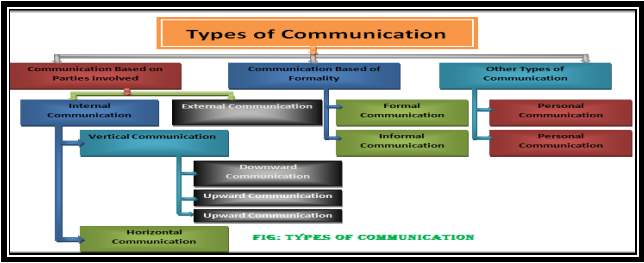

Diagram reference:(Onceno, n.d.)
PART I: QUESTION 1
(A) FORMAL COMMUNICATION
Formal communication is defined as interchange of communication officially. Basically, it is a system of passing messages and information between positions or people within an organization through officially designated channels.
Formal communication is premeditated by the management. It is an official communication which actioned over the line of authority or chain of command. The basic determination of designing such communication is to link various sub-systems of organization and synchronizing their functioning for achieving organizational goals.
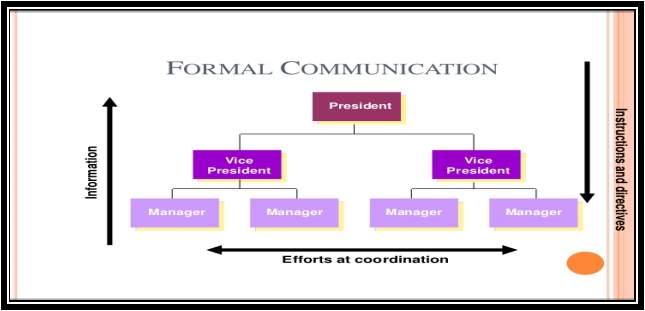
Diagram reference: (Onceno, n.d.)
The Advantages of Formal Communication are:
- Increases overall efficiency: Communication is having programmed guidelines for intensifications of general proficiency of the organization.
- Relaxed Communication: The uppermost management communicates with their employees through formal downward communication such as emails. The employees also communicate with their higher authorities using this system. It becomes much easier to communicate within the organization.
- Permanent record: A copy of formal communication is always conserved in the file and is used as reference. As a result, becomes easy to retrieve the copy of the same as and when necessary or required.
- Quick accomplishment of work: Sometimes instant communication is required by the workers. By means of the formal downward communication, it is probable to interconnect with the workers successfully hence the work gets done in a timely manner.
- Maintenance of discipline: Under formal communication system the workers are bound to be vigilant on their own duty. So eventually it maintains discipline in the organization.
Disadvantages of Formal Communication are:
- Wastage of time: Senior managements communicate with their employees by maintaining the board of chain, not by-passing any executive or any level thus it results in a lot of time wastage of the concerned person.
- Inflexibility: Generally formal communication is inflexible. If somebody in the channel intends to alter their views then it becomes impossible even though when it is needed to change, it is very difficult.
- Lack of initiative: Everybody categorizes their duty by following specific predetermined system thus becoming an obstacle towards the expansion of inspiration in the worker.
- Controlling Attitude: The correspondent has advanced authority and the receiver is inferior staffs. Commonly, the manager’s directive can’t be disobeyed. It creates an authoritarian culture in the organization.
- Lack of cordiality: The inferior workers firmly follow the order of higher authority. So, the implementer of the instruction does not observe their obligation appropriately.
MODES OF FORMAL COMMUNICATION
The four modes of formal communication are:
- DOWNWARD
- UPWARD
- HORIZONTAL AND
- DIAGONAL
1. Upward Communication:
This mode is also called Up Stream Communication. This allows to send data, recommendations, criticisms and objections of the lower level employees to the higher-level administrators. It is more participative in nature. It wasn’t encouraged in the past but modern managers encourage this in current practices thus resulting in increased democratization.
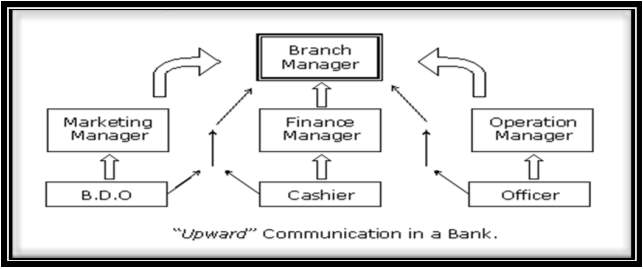
Diagram reference: (Onceno, n.d.)
Advantages of Upward Communication:
Development of plan: The information received from inferior plays an important role in development and planning of the organization.
Providing suggestions and opinions: Subordinates take into consideration any essential suggestions and opinions from superiors about the work-related issues of the organization.
Motivating to employees: Allows lower level staff to express their attitude or opinion to upper level staff. As a result, sub-ordinates are influenced to work more towards fulfillment of the targets set by the organization.
Providing constructive suggestion: All employees are supplied with constructive and important messages to help implement the goals or objectives of the organization.
Good labor-management relationship: Is participative in nature. Information’s are invited from lower level executives and employees and based on this information top executive decides on the outcome. So, a good relation between subordinates and bosses is created for the betterment of the organization.
Disadvantages of Upward Communication:
Despite having many advantages, it is not free from limitations of disadvantages as well. Some disadvantages of upward communication are as follows:
Changes information: Subordinates may change their accurate information hence resulting in inaccurate decisions by higher executives.
Unwillingness: Sometimes subordinates are not willing to send the information to their superior thus disrupting communication system in the organization.
Fear of inefficiency: Generally, superiors question about the employees work position and efficiency. This causes fear in many employees therefore they do not communicate or share their ideas, constructive suggestions and opinions with their superiors.
Indiscipline: Many times, employees tend communicate directly with their superior hence avoiding proper channel or chain of command. Here disciplines are maintained inappropriately.
Bypassing: Sometimes workers approach the higher authorities directly with their suggestions, opinions and concerns without the knowledge of their immediate boss. This is harmful to any organization.
2. Downward Communication:
This mode is also known as Down Stream Communication. In this mode communication flows, downwards. Traditionally this direction has been highlighted or emphasized created on the supposition that the individuals employed at advanced levels have the authority to interconnect to the individuals employed at inferior levels. Hence it reinforces the governing structure of the organization.
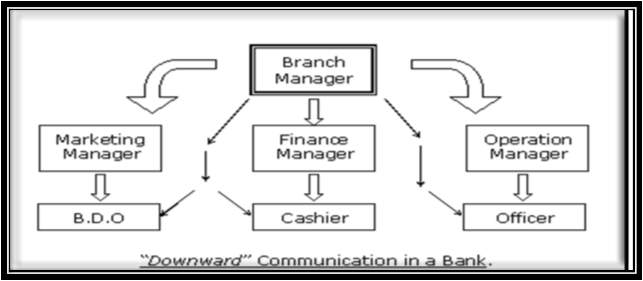
Diagram reference: (Onceno, n.d.)
Advantage of Downward Communication:
Downward communication benefits the organization in many demeanours. With this manager deliver essential data and directions to the juniors. Some advantages are as follows:
- Authority and Responsibility Delegation: Entrustment of the assistants with errands laterally with outstanding authority. It is vital to brand the assistants talented in execution of their jobs. Subsequently it jolts form advanced level to help mangers to delegate authority and accountability to the right individuals.
- Infusing Discipline: Transpires in orthodoxy with legitimately documented guidelines and protocol whilst helping in launching authorized discipline in the organization.
- Cumulative Proficiency: Delivers essential leadership, instructions, directives and clarifications of numerous intricate matters to the assistants that ultimately upsurge the competence of the workers.
- Enlightening Administrative Strategies and Measures: Highest administrators implement the strategies, guidelines, approaches, measures etc. to the inferior levels of the group for an even succession and maneuver of the organization.
- Complex Matters: Assistants want clarification of structural procedures and measures. In such circumstances, administrators depend on on downward communication to deliver required clarifications and analysis.
Disadvantages of Downward Communication:
Some of the disadvantages are as follows:
- Time Consumption: Information streams over different levels of hierarchy resulting in delayed process for the information to be received by the inferior level employees. The consequences of this is that its loses its implication and usefulness.
- Distortion of Information: Communication also suffers from problem of distortion of message. People have the inclination to alter or activate information. Consequently, data is transmitted from one employee to another or form one level to another and thus this process results in legitimacy of information being vanished.
- Lack of Enlightenment: In furthermost cases comprises of communications deprived of essential clarification and amplification whist resulting in employees failing to recognize the communication correctly.
- Weakening Connection: Considerable reliance on downward communication also worsens labor-management relationship. It doesn’t deliver any possibility of unswerving communication amid the employees.
- Lack of Response: Nonappearance of reaction is additional foremost problem of downward communication. The highest executives regularly give slight or no rank to the communications established from juniors. Managers barely pursue any response from the juniors. Due to inattention of the managers, juniors incline to rarely send feedbacks resulting communication becoming ineffective.
3. Horizontal Communication:
It is also known as lateral communication. It can be seen taking place between persons functioning at the same level or under the same executive or managers at different departments. This dimension of communication is to maintain harmonization and review activities allocated to various assistants.
This communication ascends through group meetings or discussions in which all affiliates of the group, generally aristocracies or contemporaries, interrelate and likewise in the collaboration between manufacture and advertising departments.
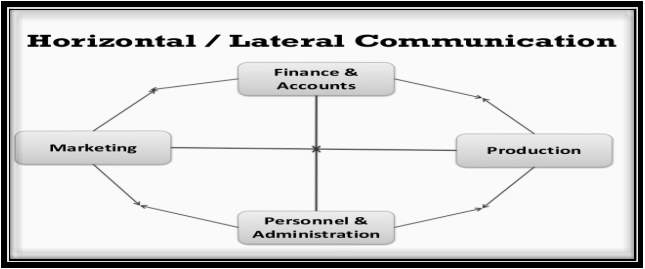
Diagram reference: (Onceno, n.d.)
Advantages of Horizontal Communication:
The communication which is occurs amongst the same status of people or parallel status level groups within the same departments or across departments is called horizontal communication. The following are some of the advantages of horizontalcommunication:
- Informal Sweet Relationship: Exchange of ideas, knowledge and thoughts at the same level can be maintained.
- Co-ordination: Inter departmental co-ordination system must be developed for achievement of an expected result of the organizations.
- End of Misinterpretation: There is abridged chances of misunderstanding amongst the employees thus it becomes very helpful to management for enhancing mutual understanding and good decision making.
Disadvantages of Horizontal Communication:
Some disadvantages of horizontal communication are as follows:
- Information Overload: Information is less filtered and due to this thorough sorting of huge amounts of data is required which leads to overload.
- Wastage of time: Excessive sorting of data wastes the useful and valuable time of superiors.
- Lack of understanding: For lack of understanding amongst employees as this communication is not successful.
- Procedural problem: Sometimes communication is disrupted for procedural problem
4. Diagonal Communication:
Also, known as crossway communication. It happens when individuals employed at the equivalent level interrelate with those employed at a advanced or lower-level of organizational hierarchy and crosswise the margins of their reporting structures.
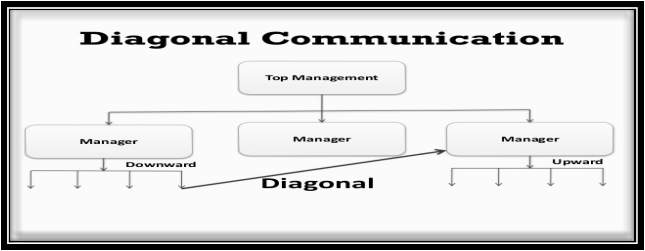
Diagram reference: (Onceno, n.d.)
Advantages of Diagonal Communication:
Diagonal communication takes place from hierarchical norms by engaging individuals who work at different levels and in different departments. The following are some advantages of Diagonal Communications.
Necessity: Business organizations are highly multifaceted, and so are the projects that are undertaken by the organisation. Projects often comprises of the cooperative efforts from more than one department and vast levels of employees within the involved departments. Furthermore, a project-group member may have a different status on the project than he has within the organization, so the hierarchy of the project group is less clear-cut than is the hierarchy of the organization. This communication allows the successful functionality of diverse groups to share information directly for the execution of the project rather than going according to that of the hierarchy that has little significance to the project.
Efficiency: The communication between an inferior in a department and a higher executive in another department can engage in a direct communication hence eliminating inefficiency.
Speed: The shortest distance between two points is a straight line and this speeds communication as the recipients receive messages directly and instantly which is necessary for successful operation of the organisation.
Challenges: Eventually the management determines whether diagonal communications are appropriate. It’s also important to trust individuals who can use them in a cooperative manner solely for the benefit of the project by maintaining the exchange at a formal-communications level only.
Disadvantages of Diagonal Communication:
Distortion: Messages may be partial due to language issues, inattention or lack of clarity and cultural differences. Even when employees share the same first language, word choice may lead to ineffective communication if an employee uses jargon or emotive language. Listening skills are an important element of communication. Lack of attention by the receiver may result in distortion.
Information Overload: Employees receive a huge level of communication over a short period of time which leads to overloaded and hence the employees struggle to process all the information. This also results multiple short messages or one overly complex message. Advances in communication technology such as the increased use of email has led to quicker and easier workplace communication. However, technology has increased communication to the point where users must adopt self-management techniques to avoid being overwhelmed by information.
Interpretation: Contradiction between a person’s words, tone or body language may create barriers to communication. An employee may receive positive feedback from his manager but may not believe the feedback if the manager avoids eye contact or his body language appears insincere. Equally, an employee who receives negative feedback may justify it by deciding that his manager dislikes him, rather than accepting that his performance is below standard. Receivers may interpret communication based on their experience.
INFORMAL COMMUNICATION
Informal communication is referred as a communication which flows in every direction. It does not follow any pre-defined network for transmission of information. This communication moves freely in all directions and thus it is very quick and swift. In any organization, this type of communication is very natural as people interact with each other about their professional life, personal life and other matters.
Casual form of sharing information is characteristically used in private discussions with families’ members. Inside a professional atmosphere informal communication is occasionally also termed as grapevine and capacity be practical happening in discussions, automated mails, text messages and phone calls between entertaining workers.
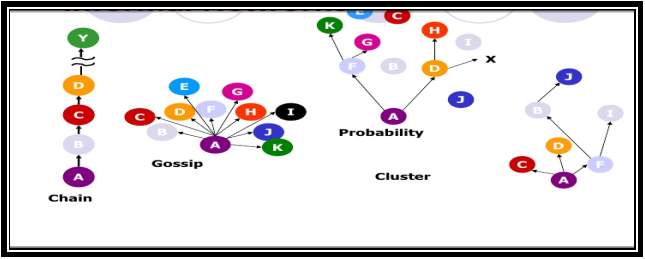
Diagram reference: (Onceno, n.d.)
The Advantages of Informal Communication are:
The advantages of communication are as follows:
- Fast and Effective Communication: The messages move fast and is equally and greatly effective on people.
- Free Environment: Its done in a free environment. Free environment means that there is no pressure of any office-big or small. The employees react openly and collectively at the same time.
- Better Human Relations: Helps the establishment of better human relations as this eases employee from tension & gives the more freedom.
- Easily Solves Difficult Problems: Some problems which can’t be solved with the help of formal communication. Therefore, freedom in informal communication helps to easily find solution of difficult problems.
- Social Needs Satisfaction: All employees need good relationship with the higher management executives at the place of their work. Such relations give satisfaction to the employees at the same time making them feel proud. This is only made possible with the help of the informal communication in the organisation.
The Disadvantages of Informal Communication are:
Some disadvantages of informal communication system are as follows:
- Distortion: This does not track any set of rules, certain facings or conducts and can convey any type of data to any individual deprived of any reverence or distress. It might blowout incorrect or imprecise update which even occasionally proves to be destructive to the employees.
- Limited Secrecy: Everyone can spontaneously interrelate as there are no constraint or guidelines. Slightly secret factual is possible to be spread deprived of any badly-behaved or reluctance. This might source a enormous mutilation to any association or member.
- Inadequate Information: Information released from such communication network is usually incomplete. There is very high chance of it to be misunderstood or misinterpreted.
- Non-Co-Operation: Confusion develops amongst the individuals. Consequently, resulting in the employees to continue to be distinct or deprived of any co-operation.
- Lack of Confrontation: Doesn’t follow any recognized structure and is somewhat outside of regulator. Association has no apparatus to resist its undertaking.
GRAPEVINE COMMUNICATION
Grapevine is an informal channel of business communication. It bounces throughout the organization in all directions irrespective of the authority levels. Despite the presence of formal channels in an organization, the informal channels tend to progress while intermingling with other people in organization. It occurs largely at lower levels of an organization.
Grapevine commonly advances due to various reasons. One of them is when an organization is facing recession phase, the employees sense uncertainty in the organisation. Employees start to have a tendency in losing self-confidence due to which they form unions. The managers tend to show privileged conduct and favour some employees giving an isolated sensitivity to other workers.
Accordingly, after worker’s intellect a necessity to discuss their opinions prefer to go for grapevine network as they can’t use the formal channel of communication. Generally during breaks in cafeteria, the co-workers talk about their superior’s attitude, behaviour and exchange views with their peers or spread rumours around advancement or transmission of other workers. Therefore, grapevine spreads comparable to fire and it is not difficult to trace the source of such communication at all times.
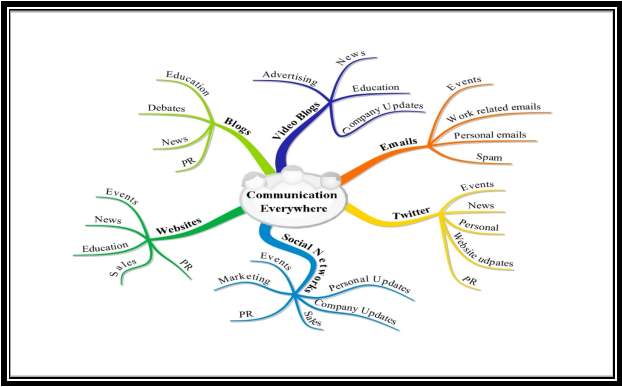
Diagram reference: (Onceno, n.d.)
Grapevine Communication Advantages:
- Grapevine carries information rapidly. Employees tend to know some confidential information and becomes inquisitive about it whilst spreading the details to co-workers who in turn passes it to other employees. Thus, information spreads hastily.
- The managers tend to have the reactions and feedbacks of their assistants on their strategies and plans. The feedback obtained is much faster compared to the feedback obtained by formal channel of communication.
- Generates a sense of unity amongst the employees who share and discuss their views with each other. This helps in developing group boldness.
- It serves as an emotional support towards the cultural values of employees.
- Is a supplement in those cases where formal communication doesn’t work.
Disadvantages of Grapevine Communication:
- Carries partial information at times as it is mostly based on rumours and it does not clearly depict the complete state of affairs.
- Not always trustworthy as official path of communication is not followed and the same is spread further by gossips and unsubstantiated reports.
- The efficiency of employees becomes vulnerable and tend to decrease as they spend more time on gossips rather than working.
- Creates aggression against the executives by employees or vice versa.
- Hinders the goodwill of the organization by carrying false and negative information about the hierarchy of the organization.
A smart manager must take care of all the disadvantages of grapevine and minimizing them while making the best possible use of its advantages as well.
(SkillMaker, n.d.)
(B) THREE EXAMPLES OF FORMAL COMMUNICATION
- The production and the marketing departments must interact with each other because marketing tactics and production planning go together with each other.
- The Creditors Accounts Officer submitting creditors report to the accountant for review
- General Manager Operations sending an email to all employees in respect of a meeting in regards the company restructures and implementation of new policies and procedures.
THREE EXAMPLES OF INFORMAL COMMUNICATION
- Assume the profit amount of a company is leaked out and the suddenly the rumour is spread regarding the profit made by the organisation and on that basis bonus will be declared.
- The CEO of an organisation may be in relationship with the Production Manager. Even though they may have friendly but professional relation with each other than gossip is spread about this and thus this becomes a much-talked topic within staffs & colleagues during their breaks.
- Talking to your friends, family or work colleagues on the phone or in person about personal or professional matters relating to yourself or about any third person.
(SkillMaker, n.d.)
Conclusion
Formal and informal structures can be both beneficial and detrimental to an organization contingent on how well they are understood and actioned. Formal structures should be assessed as the organization grows or takes on new errands. Understand the informal structure of your company as thoroughly. Groups progress into an informal unit making lot of sense and are more effectual and industrious than formally structured groups. Using the same advantage, organizations even consider putting some informal structures into a more formal part.
Presently many Multinational Organizations has started an open-door policies hence allowing all employees of any department to communicate directly with the head of an organization regarding their complaints, grievances, and requests whilst consequential in reducing the intricacy of the formal communication.
(SkillMaker, n.d.)
PART I: QUESTION 2
(A) CULTURE
Culture exemplifies the accepted norms and values and traditional behaviour of a group. However, culture also advances over time. Culture of each country partakes its own beliefs, values and activities. Culture is also defined as developing set of collective beliefs, values and attitudes.
Culture is a key component in any business and has a huge influence on the tactical direction of business. Culture stimuluses management decisions and business functions from production to accounting and other operations of the organisation. Principally culture is only one aspect in the business organisation. Culture has its own exclusive measurement of meetings, negotiation, formalities, social media use, practicums and work appointments and other fundamentals.
“Culture is prearrangement of different attributes that prompt an organization and distinguish the firm from one another (Forehand and von Gilmer, 1964). According to Hofstede (1980), culture is the cooperative intellectual of minds which generate a variation between the members of one group from another. As per Schein (1990), defines culture is set of diverse values and behaviors that are considered to guide success of an organization. According to the Kotter and Heskett (1992), culture means recognized set of beliefs, behaviors and values that a society generally contains. In simple words, we can understand that culture is gained knowledge, explanations, values, beliefs, communication and behaviors of large group of people, at the same time and same place” (Mishra, n.d.)
Business culture is interrelated to behavior, ethics, custom and more. A business culture will incorporate as organization’s values, visions, working style, beliefs and habits
Organizational culture represents the unique personality of an organization. Every company has its own unique personality, just like people do. Organizational culture is an invisible where people work together as a group but is a powerful force that influences the behaviour of the members in the group.
Organizational culture is a system of shared assumptions, values, and beliefs, which administers how people behave in organizations. These values have a strong influence on the people in the organization as on their dressing sense, actions, and perform of their jobs. All organization develops and preserves a unique culture, which delivers guidelines and boundaries for the behaviour of the members in the organization.
Culture is conveyed to employees in several forms, the four most common ones are:
STORIES:
Stories characteristically comprises a chronicle of significant events or people including such things as the organization’s forefathers, guidelines infringement, responses to past mistakes, and so forth. CEOs and other figureheads often have stories or legends related with them; this creates culture through admiration.
RITUALS:
Rituals are repetitive sequences of activities that prompt and emphasize the values of the organization like what goals are most important, which people are important and which ones are surplus. In the business setting this is simply the way in which employee interactions are organized. One example is the weekly staff meeting.
HEROES:
Heroes preserve the organization’s underlying values, become role models to symbolize the organization from others and set performance standards that motivate other participant achievements.
SYMBOLS:
Most organizations have brand images and other symbols or logos, etc. which represent what the culture stands for in the organization.
These symbols transmit to employees who is important, the degree of equivalence anticipated by hierarchy and the kind of behaviour that are anticipated and appropriate.
(Mishra, n.d.)
(B) RELATION EXPLAINED IN CONTEXT OF THE ORGANISATION
Stories:
Stories of an organization’s heroes are powerful tools to strengthen cultural values throughout the organization and specially in positioning innovative workers. Stories deliver major instances where people can learn from and practise the use of same to achieve success in their work life. Stories are often riddled through a cultural network and recap workers as to why we do things in a convinced way. To support workers, learn the culture, they reveal what is important to the organization.
“Nike has many senior executives who devote considerable amount of their time serving as communal story tellers. They are preordained to transmit what Nike is about. When they express the story of how cofounder (and Oregon track coach) Bill Bower went to his workshop and dispensed elastic into his wife’s waffle iron to produce an improved running shoe, they’re speaking about Nike’s essence of modernization. When new hires overheard tales of Oregon running star Steve Prefontaine’s encounters to brand running a professional sport and to accomplish improved performance gear they learn of Nike’s assurance in serving athletes.” (Mishra, n.d.)
Stories such as these mingle through many organizations. They characteristically comprise a description of events around the organization’s founders, regulation breach, rags-to-riches accomplishments, decrease in the workforce, repositioning of employees, responses to past mistakes, and organizational surviving. These stories represent the present in the past and deliver clarifications and legality for existing performances.
Rituals:
Rituals replicate such activities that are endorsed frequently on significant instances. Affiliates of the association who have attained victory are recognized and rewarded on such occasions. For instance, honors given to workers on “forefathers’ day”, Gold medals specified to schoolchildren on graduation day are replications of culture of that foundation.
“Unique and well Known trade rituals is Wal-Mart’s company chant. Begun by the company’s founder, Sam Walton to motivate and bond his workforce, “Gimme a W, gimme and A gimme and L, gimme a squiggle, give me an M, A, R, T!” has developed a company ritual that ties Wal-Mart workers and strengthens Sam Walton’s belief in the reputation of his workers to the company’s success. Alike corporate chants are used by IBM, Ericsson, Novell, Deutsche Bank, and Pricewaterhouse coopers.” (Mishra, n.d.)
Rituals are another key aspect in generating organizational cultures in the everyday activities and celebrations that characterize the organization. Furthermost fruitful organizations sense that these rituals and symbolic activities should be accomplished. Through rituals, appreciation of attainment is conceivable. The Teacher of the Year Award and National Merit Schools are instances of the same. Likewise, numerous traditional rituals may escort the appointment of a new administrator of schools, including press and other announcements, meetings, and speeches. Some organizations have even fashioned their own reward rituals.
At Hollibrook Elementary School in Spring Branch, rituals reinforce students learning. Under the leadership of the principal and faculty, and reinforced over ties to the Augmented Schools Model, the college established several ethnicities to generate a influential professional culture and auxiliary amplified student success. For example, faculty meetings became an emphasis of proficient interchange and dialogue of practice and available research. “Fabulous Friday” was formed to deliver schoolchildren with an extensive collection of developments and activities. A “Parent University” provides courses and materials while maintaining trust amongst the school and the basically Hispanic community. Norms of collegiality, enhancement, and acquaintances sustenance and denote what the school is about.
Heroes:
Most successful organizations have their heroes. Heroes are of two types (I) born and (ii) created. The born hero is the impracticable institution builder like Henry Ford, founder of the Ford Motor Company, Walt Disney, creator of Disney Studios and theme parks, and Mary Kay Ash, founder of Mary Kay Cosmetics. Created heroes, on the other hand, are persons the establishment has made by perceiving and reveling extraordinary moments that transpire in the day-to-day life of the organization. Thomas Watson, former head of IBM, is an example of a situation hero.
Other well-known heroes include Lee Iacocca at Chrysler, Sam Walton at Wal-Mart, and Vince Lombardi, the legendary coach of the Green Bay Packers. In many schools, local heroes and heroines—paradigms of fundamental ethics—offer hero replicas of what everybody would be determined for in the college/institute. These extremely devoted workers come in early; are constantly enthusiastic to encounter with schoolchildren; and are continuously advancing their services.
Symbols:
Symbols interconnect organizational culture by implicit communications. As soon as you walk into diverse businesses, you get a “impression” for the place –formal, casual, fun, serious, and so forth. These states of mind you get divulge the power of symbols in generating an organization’s temperament. Material artefacts shaped by an organization also speak of its cultural alignment and make a announcement about the company.
Examples: – allocated car parks for senior executives in the company premises, huge offices specified to senior managers, extravagance vehicles given to senior or successful officers of the organization.
(C) IMPACTS OF COUNTRY CULTURE
Timings:
Attitudes to time may differ between different cultures in often quite significant ways. For example, being late for an appointment, or taking a long time to get down to business, is accepted as normal in most Mediterranean and Arab countries, as well as in much of less-developed Asia but in American and other developed countries it is unacceptable. For example, being on time refers to no expected delays of less than one minute, while in many other countries, delays of up to fifteen minutes’ leeway is still considered on-time.
Some cultures value time more than others, but this opinion may not be an accurate classification of the circumstances. Moderately, representatives may value inversely the amount of time dedicated to and restrained in contradiction of the goal pursued. Trendy circumstance of Americans, the agreement is a signed indenture and time is money, so they need to make a deal swiftly. Consequently, try to diminish procedures to a lowest and get down to business as hurriedly as probable.
On the other hand, Japanese and other Asians try to create a relationship rather than simply sign a contract. They capitalize time in the conveying procedures so that the parties can get to know one another well and legalize whether they wish to embark on a long-term relationship. They deliberate hostile efforts to abridge the conveying time as exertions to hide something.
Numerous people animate principally outside clock time, particularly the young, old, idle, disabled, dejected or persistently ill. Clock time is likewise less significant at times of vacation, ritual or religious fervour, and there are frequently transformations amongst the speeded-up time of the city and the slower time of the countryside.
WORK ETHICS:
Ethics are the moralities and values that an individual uses to rule his happenings and verdicts. In an association, a code of ethics is a established as moralities that guide the organization in its agendas, strategies and outcomes of the business. Henceforth country culture has negative & positive impacts on work ethics of a company.
Workplace ethics creates positive atmosphere at the workplace which leads to happy and satisfied employees who adore coming to work relatively than thinking of it as a measly cause of problem.
Workers similarly progress to a sensation of trustworthiness and addon to the association. Nevertheless, culture does affect work ethics as employees are unable to understand each other’s culture and languages thus this leads to misunderstanding and to certain extent hatred for each other hence the performance of employees is affected in ways such as incomplete project or lower production level.
Cultural struggle in consultations tend to transpire for two main motives. Primary, when opposing cultural modifications, we incline to rely on stereotypes. stereotypes are often critical (for example: Italians always run late), and they can lead to prejudiced prospects around your complement’s and behaviour as well as theoretically instigating misapprehensions.
As a auxiliary of trusting on stereotypes, try to focus on prototypes—cultural medians on scopes of behaviours or values.
For example, it is frequently understood that Japanese delegates incline to have more silent periods during their talks than others. There is still a great deal of unpredictability inside respective culture—denotation that about Brazilians express fewer than approximately Japanese do.
Therefore, it would be a mistake to visualize a Japanese representative you have not ever encountered towards to be earmarked. Nonetheless it cracks out that a representative is exclusively inaudible, you might well appreciate their behaviours considering the prototype. Accumulation, consciousness of your own cultural examples can help you antedate in what way your counterpart might understand your negotiating behaviours.
GENERAL WORK BEHAVIOUR
Cultural influences on personality is significant as Western ideas and theories are not necessarily applicable to other cultures. The strength of personality and characters differs significantly across cultures.
Individuals living in nonconformist cultures incline to rate unconventionality, struggle, and individual attainment very extremely however individuals from communist cultures incline to rate communal agreement, consideration, and collection desires very highly.
Similarly, culture can affect character and performance. It also highlights diverse characters amongst dissimilar femininities and thus impact the progress of one’s behavior. In the U.S., hostility and decisiveness are highlighted as confident qualities for males, while obedience and caretaking are highlighted for females. The strength of character personalities varies across cultures, and this is mostly precise of once relating nonconformist cultures (such as European, North American, and Australian cultures) and collectivist cultures (such as Asian, African, and South American cultures). Individuals who live in nonconformist cultures incline to trust that freedom, rivalry, and individual accomplishment are substantial.
In disparity, individuals who live in collectivist cultures incline to rate common resemblance, consideration, and cluster desires over separate desires. These ethics impact nature in dissimilar but considerable conducts; for example, Yang (2006) initiate that persons in nonconformist philosophies demonstrated additional, generally focused on nature personalities, however individuals in collectivist cultures demonstrated more informally focused on temperament personalities.
THREE RECOMMENDATIONS
Always be Punctual:
Western world deems time in the form of money or merchandise and can be disbursed, unexploited, protected or specified. It can be permitted, extra, additional or intensely. Time is always transformed into money, and money converted into time, besides this progression can be indeed measured. Time and work are closely correlated: in manufacturing culture, time, labour, wages and production are all related to each other, through the general intention of larger productivity, at a lower cost, and in a shorter time frame. In industrialized countries, therefore, there is a multilateral division of the human life cycle, especially among men, into three periods: pre-work (childhood, adolescence, education), work, and post-work (retirement, unemployment or infirmity).
By contrast, in many traditional agricultural societies all children are trainee adults, and are expected to help in tending to crop, livestock, or caring for younger siblings from very early on. Time devoted to work is therefore considered as fundamental to childhood as to adulthood.
Learn Other Cultures:
Enchanting the time in exploring or querying about each other’s culture can drive an extensive method to brand them on their impression easily. Acquire around the possessions of customers and similarity and worth, food, customs and etiquette, professional practices and fun activities. Meanwhile there is a mass of data accessible online which can be easily used to determine the uncomplicated beliefs of the culture. Since additional determination is needed will make the individuals or co-workers sense treasured and are more suitable to acclaim to do business through you in the future.
Remain Accepting:
If your workers, customers or employees partake traditional necessities such as prayer times or spiritual outings, accommodate their desires into your work agenda. As definitely you will want somebody to respect your culture.
Irrespective of your business nature, possess an uncluttered mind. Identify that your technique is not the only method. There is no essential for alteration to your culture or influence others to modify theirs, but relatively discover mutual ground where everyone can appreciate, respect and grip ethnic variances.
(Mishra, n.d.)
Summary & Conclusions
Everyone or workers in the association has own diverse morals and principles that they work with. When joining any organization, they allow them self to adopt first with the organization’s culture to know whether can they cope up with them or not. Culture is being explored to impact selection of organizational process. Organizational culture has a cavernous influence on the performance of workers that can source to progress the efficiency and improve the administrative performance. It can be accomplished that organizational culture has a optimistic influence on the worker’s job performance. Each individual in the organization has different culture and they first try to adjust with the norms and values of the organization. The adoption of culture of the organization is helpful for the employees to do their work efficiently and effectively. Employee performances can increase organizations net profits.
Optimistic expansion is calmer to accomplish when everybody is on a mutual track in the association. It is observed that sturdy organizational culture is very supportive for the innovative workers to accept the organizational culture and to get the viable benefit beneath the circumstances. Worker’s obligation and collective productivity plays very vital role to accept the value and beliefs of the organization and ornamental to the performance of the organization. (Cullen, n.d.)
PART II: STRENGTHS, WEAKNESS & ACTION PLAN FOR PROFFESIONAL, WRITTEN, GROUP & PRESENTATION
| PROFESSIONAL | WRITTEN | GROUP | PRESENTATION | |
| STRENGTHS | Strong attention to detail. | Determination | My attitude towards the team members | Disciplined |
| WEAKNESS | Being too critical of myself | Attempting to please everyone | Judging an individual | I get nervous, due to this fear of public speaking I am not able t
o present myself more passionately |
| ACTION PLAN | Focus on the positive side. To work well under strict deadlines and with intense pressure. | Negotiate off duty with mentor considering the requirement to achieved a minimum of 50% contact time with mentor and the needs of the service. | Individuals must be judged by so many parameters and not only by characteristic or comparison. | Build self-confidence by regularly telling yourself that you can overcome your weakness. Ability to move beyond mistakes and failures. Set reachable goals |
| OBSTACLES TO IMPLEMENT STRATEGIES | Planning is the most problematic encounters to executing a approach in arranging your exertions and influential timing, categorization, and resources vital to magnificently achieve each stage in your plan. Failure to do so can demoralize the whole process |
Lack of resources to accomplish everything you’d like to achieve. | Responsibility given to team members were taken very lightly by ignoring the work given.
In any industry, team collaboration is crucial for achieving the predominant goals. Inappropriately, deprived communication amid subdivisions or co-workers has demonstrated to be the disgrace of even the utmost approaches. |
This can be a predominantly complicated one. Characteristically, the bigger the obligatory change, the bigger the confrontation may be. This is factual particularly if reviewed approaches involve that you restructure a subdivision or regulate worker errands. The confrontation can demoralize the successful execution of your approach |
| RESOURCES REQUIRED TO SUPPORT STRATEGES | Mentor | Link Lecturer | Policy Manuals | Mentor |
| BUDGET ALLOCATED
|
$ 80.00 | $ 50.00 | $ 40.00 | $ 60.00 |
| TIME FRAME | 1 month | 1 month | 2 Months | 3 Months |
| MEASURE PERFORMANCE | Quality of work | Observe personal habits | Check their attitude | Review personal presentation |
Conclusion
To advance performance, we must measure its peripheral and viable atmosphere. This will disclose the important prospects it can benefit from and the intimidations it must deal with. Retort equally to interior and exterior matters in a practical and energetic means by using its strengths and dropping its weaknesses. This can generate the strong growth needed to retain a strong identity in the market.
Desire syndicates strategy, low-slung values, cost-effective use of resources, and accountability for individuals and the atmosphere. A company’s products, developments and schemes all reveal its ecological attitude. For example, ingenious usage of wrapping and design means more objects can fit into a jalopy, which means less conveyance trips hence reducing costs.
REFERENCES
Bappi, O. C. (n.d.). what-is-formal-communication.html. Retrieved from the-business-communication: blogspot.co.nz/2013/04/
Cullen, S. (n.d.). Quantum Learning Solutions, Inc. Retrieved from http://www.quantumlearn.com
Mishra, D. D. (n.d.). principles-of-management-and-organisational-behaviour. Retrieved from tutorial-366/successful-organizational-culture-12929.html: https://www.wisdomjobs.com/e-university
Onceno, D. (n.d.). business-information-system. Retrieved from aiamieh/business-information-system: https://www.slideshare.net
SkillMaker. (n.d.). informal-communication. Retrieved from informal-communication: http://www.skillmaker.edu.au
Cite This Work
To export a reference to this article please select a referencing stye below:
Related Services
View allRelated Content
All TagsContent relating to: "Business Ethics"
Business Ethics are policies and best practices that must be adhered to, relating to behaviour and morals, as well as other potentially controversial topics.
Related Articles
DMCA / Removal Request
If you are the original writer of this dissertation and no longer wish to have your work published on the UKDiss.com website then please:




